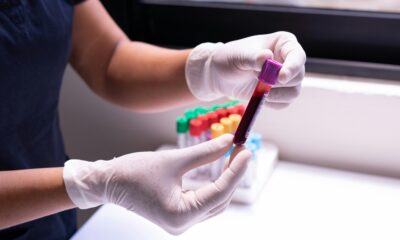Lifestyle
The Lasting Impact of Camp Lejeune Water Contamination on Children and Women
Published
7 months agoon

In the mid-20th century, Camp Lejeune, a United States Marine Corps base located in North Carolina, was a hub for military families and personnel. However, a devastating environmental hazard began to unfold within the premises of this once-thriving community.
It led to one of the most significant cases of water contamination in U.S. history, impacting the lives of thousands associated with Camp Lejeune.
The consequences of this contamination have left a lasting impact on the health and well-being of children and women associated with the base.
Understanding the Camp Lejeune Water Contamination
Camp Lejeune, spanning 256 square miles, is a US Marine Corps Base in North Carolina’s Onslow County. Since its establishment in 1942, it has functioned as a training and residential center for military personnel and their families.
The base includes living quarters, administrative offices, hospitals, schools, and recreational areas, accommodating around 170,000 individuals, comprising active-duty personnel, family members, and civilian employees.
Tragically, the contamination at Camp Lejeune originated from volatile organic compounds (VOCs), notably trichloroethylene (TCE) and perchloroethylene (PCE), which seeped into the water supply.
Studies by the National Library of Medicine found that these compounds surpassed the EPA’s maximum contaminant levels (MCL), exceeding 5 parts per billion. TorHoerman Law notes that the levels detected were notably higher than the permissible threshold set by the Environmental Protection Agency.
The harmful substances, commonly used in industrial processes and cleaning solutions, persisted undetected in the base’s drinking water for several decades. This spanned from the 1950s to the 1980s, exposing numerous military families, including women and children, to substantial health risks.
Impact on Pregnant Women
Pregnant women residing on the base during the contamination period faced significant health risks. Exposure to these hazardous compounds heightened the potential for adverse pregnancy outcomes, as indicated by the Agency for Toxic Substances and Disease Registry (ATSDR). Studies have established a correlation between these chemicals and potential cancer-related symptoms and birth defects in both humans and animals.
According to Consumer Notice, in 2013, the ATSDR conducted a study involving 12,598 mothers residing at Camp Lejeune between 1968 and 1985. The findings suggested that exposure to TCE and benzene during the initial trimester of pregnancy increased the risk of neural tube defects.
These defects affect the brain and spinal cord, revealing the concerning impact of exposure to these compounds during early pregnancy.
Moreover, mothers who encountered contaminated water while residing on the base reported instances of miscarriages and stillbirths. The Department of Veterans Affairs (VA) officially acknowledged miscarriages as one of the conditions associated with Camp Lejeune.
Additionally, ATSDR’s research demonstrates that expectant mothers exposed to TCE faced elevated risks of giving birth to babies with heart defects.
Dr. Ann Aschengrau, leading a team of scientists at the Boston University Superfund Research Program, investigated children exposed to PCE through water contamination in Massachusetts.
They found that infants exposed to PCE in the womb were three times more likely to develop cleft lip, palate issues, and neural tube defects.
Heartbreakingly, a portion of the cemetery just outside Camp Lejeune earned the poignant nickname “Baby Heaven.” This designation emerged from the burial of numerous babies who tragically passed away due to miscarriages and stillbirths within the base’s community.
Mothers, grappling with the heart-wrenching loss of multiple children during pregnancy, shoulder a shared burden of severe health conditions. These include profound neurobehavioral effects, serving as a poignant reminder of the lasting suffering endured by those linked to Camp Lejeune.
Effects on Children
During the contamination period, children who grew up at Camp Lejeune encountered considerable health adversities. Exposure to TCE and PCE early in life has been linked to an increased risk of childhood cancers, such as leukemia and non-Hodgkin lymphoma.
A federal study in 2003 highlighted an alarming finding. The childhood cancer rate at Camp Lejeune was a staggering 15.7 times higher than the national average, emphasizing the severity of the situation.
Additionally, the exposure to these toxins resulted in developmental issues, learning disabilities, and behavioral challenges among the affected children. These adverse effects significantly impacted their quality of life and posed obstacles to their educational progress.
Health Challenges Persisting Through Generations
The legacy of the Camp Lejeune water contamination isn’t confined to those directly exposed. Studies suggest that the health repercussions may transcend generations.
Research suggests that the genetic changes stemming from parental exposure to these harmful compounds might impact the health of grandchildren.
This potential effect could perpetuate the adverse consequences across subsequent generations, emphasizing the long-term impact of the exposure on familial health.
Legal and Government Response
In the wake of mounting evidence and advocacy efforts, the U.S. government acknowledged the gravity of the situation. They have established the Camp Lejeune Family Member Program. This initiative was designed to offer healthcare coverage to those impacted by the contamination, aiming to address the fallout through Camp Lejeune compensation.
In conjunction with these initiatives, a convoluted and protracted legal process seeking justice and compensation emerged. This was evident through the filing of over 1,100 lawsuits and more than 117,000 administrative claims as of January 2024.
Advocacy, Support, and Moving Forward
Several advocacy groups and organizations have emerged to support the affected families, offering resources, information, and a platform for collective action.
These groups have played a crucial role in raising awareness and advocating for legislative changes in response to the Camp Lejeune water contamination. Additionally, they’ve provided essential support and a sense of community for those affected by the crisis.
In conclusion, the Camp Lejeune water contamination stands as a stark reminder of the devastating consequences of environmental negligence. The toll it has taken on the health and lives of children and women associated with the base is immeasurable.
While efforts have been made to provide support and address the aftermath, the need for ongoing research, healthcare assistance, and comprehensive solutions remains paramount.
It’s crucial to continue advocating for justice and support for the victims while striving to prevent similar tragedies from occurring in the future.
Recent News


4 Amazing Trips for Your Family
Choosing somewhere for a family vacation that would pique the attention of adults and kids alike can be a fun...


Customising Your Makeup with Blendable Blush Options
In cosmetics, one’s face is a canvas for self-expression and creativity. Among the myriad of products available, blush is a...


The Benefits of Regular Home Maintenance
Regular home maintenance is essential for maintaining and even raising the value of your house. A proactive approach to repairs...


Understanding the Importance of SEO in Adelaide
In the digital marketplace, Adelaide businesses are in a continuous contest to gain the attention of their target audiences. With...


Breaking Down the Numbers: Understanding the Average Traveling Nurses Pay
The open road, adventure, and the chance to heal – travel nursing promises an undeniable allure. But amidst the excitement,...


Dealing with Oily Skin in Summer: Tips and Tricks
As the temperature rises, those with oily skin often face an additional challenge—maintaining a clear and balanced complexion. Excess oil...


Mountain Wedding Ideas for 2024
A mountain wedding is a stunning choice for couples who cherish nature and desire a distinctive wedding experience. Whether you...


3 Of The Best Ways To Keep Your Salon Clean
It is of the utmost importance to ensure that a salon is kept scrupulously clean, not just for the sake...


3 Reasons You Should Get Blood Tests Every Year
Regular blood tests are essential for preserving general health and identifying potential problems early on. Medical professionals can evaluate your...


How to Make Your Next Crafts Project Pop
Crafting is a creative outlet that allows individuals to express themselves through various mediums such as paper crafts, sewing, painting,...
